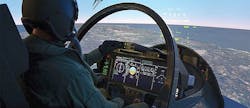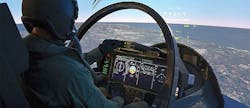Leonardo DRS, Honeywell, CAE technologies deliver embedded training, simulation onboard aircraft
ARLINGTON, Va. Former Israeli Air Force commanders discuss their decision to train fighter pilots on the M-346 jet trainer, which is the platform on which the advanced T-100 airplane and integrated training system will be based.
The aircraft will be built in the U.S.A. in Tuskegee, Alabama, the engines will be built by Honeywell in Phoenix, Arizona, and the ground-based training system will be built by CAE in Tampa, Florida.
The advanced cockpit-embedded tactical training system integrates with multiple aircraft and ground-based training devices can only be found on the T-100. It’s comprised of embedded simulation on-board the aircraft to train students for the most different missions; simulators and ground-based instructional devices, including an operational live, virtual and constructive (LVC) environment that are linked to the jet in-flight for added realism and efficiency. So, for all levels of training, the T-100 satisfies the needs of the U.S. Air Force’s T-X program.
A comprehensive in-flight Embedded Tactical Training Simulation (ETTS) suite is a key feature of the T-100 and core element of the Integrated Training System (ITS).
ETTS enables the T-100 to offer the whole spectrum of simulated training functions in-flight and provides both students and instructors with the following on-board simulations:
- A tactical scenario (digital map with threats and targets)
- Presence of realistic Computer-Generated Forces (friend and foe)
- On-board sensors (such as multimode Fire Control Radar, targeting pod and active/passive electronic countermeasures)
- Weapons, including specific symbology and delivery parameters
- Live, Virtual, Constructive (LVC) enabled
ETTS functions can support Stand Alone (flying a single-ship mission) or Multi-Ship networked operations, with aircraft and simulators being networked via a dedicated Training Datalink to exchange Tactical Scenario data with other participants.
Honeywell, a member of the Leonardo DRS T-100 team, provides two high thrust-to-weight ratio F124 low-bypass turbofan engines power the aircraft, designed to prepare the next generation of U.S. Air Force pilots to fly fifth-generation fighters like the F-35 and F-22.
According to Honeywell: "The Leonardo T-100 is more than a great airplane. It’s the centerpiece of an Integrated Training System that will set a new standard for pilot training. As the T-X competition for the new trainer moves into the evaluation phase, the Leonardo team is offering the Air Force the most complete, proven, operational and integrated training solution."
The training system includes embedded tactical simulation on the aircraft plus simulators and ground-based instructional devices, including an operational live, virtual and constructive (LVC) environment that provides extraordinary fidelity for trainees. The T-100 system meets the Air Force’s need for a trainer that can prepare pilots for today’s most advanced fighters without the need for an intermediate training aircraft.
The T-100 lets students practice in an airplane with the same capabilities – the same “feel” – as the fifth-generation fighters they will eventually fly. This is thanks in large part to the Honeywell engines, which deliver all the power, performance and responsiveness needed for every phase of the training syllabus, officials say. Trainees will have practiced a given maneuver many times in ground-based simulators before strapping into the actual aircraft. The T-100 simulators are so advanced that a student flying an actual aircraft can practice formation-flying with another student in a ground-based simulator as wingman.
Leonardo’s Integrated Training System will let the Air Force accelerate the training cycle and focus more attention on the advanced jet portion of the curriculum, conducting training that would otherwise need to be accomplished in a fighter – at less than one-fourth the cost, officials say. "A terrific airplane and a one-of-a-kind Integrated Training System makes creates an unbeatable combination for the U.S. Air Force. No wonder that all of us on the Leonardo team have embraced the slogan, 'We don’t just build airplanes, we build pilots.'”


